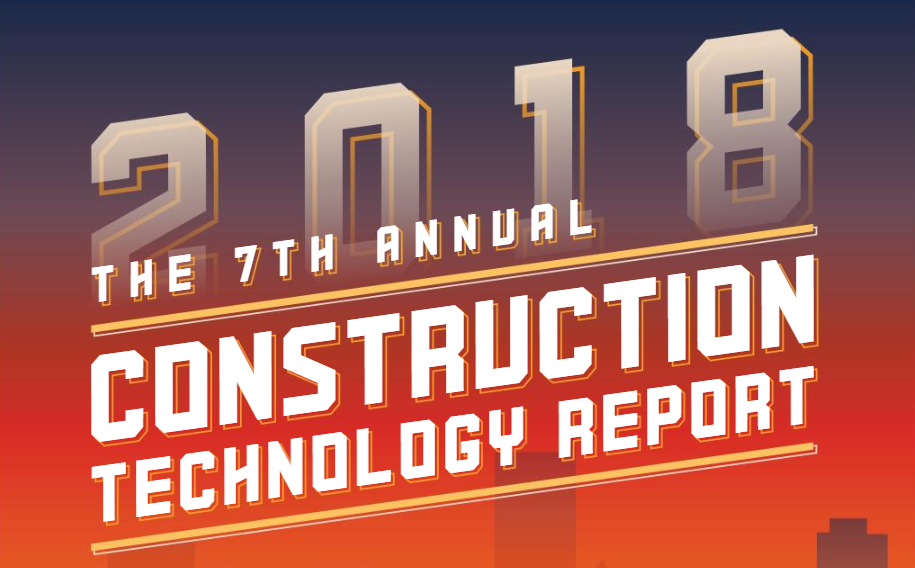via the 2018 Construction Technology Report from JBKnowledge
JBKnowledge, a construction technology and consultancy company, has been producing their annual Construction Technology Report since 2012. Now in its 7th year, it is far and away the most comprehensive collection of survey results in the construction technology sector.
Each year, the survey has accumulated more respondents than the year prior and the 2018 Construction Technology Report was no different, totaling 2,825 respondents versus 2,690 in 2017. The report aims to find trends that contractors across the country are following and their overall feelings toward adoption of new technology.
As always, I encourage you to visit their website and view the full 2018 ConTech Report, but I wanted to highlight a few of the findings that I found to be most interesting.
IT Spending
With an increase in awareness in construction technology across the industry, it was a little bit of a surprise to see the results show that IT spending was stagnant over last year, with the vast majority of respondents (46%) saying that their company spends less than 1% on IT. 41% also say that they’re not billing expenditures to projects, which I assume means directly as opposed to including it in their overhead.
Mobile Technology
Smartphones continue to lead the way in most used mobile devices daily, leading laptops, tablets, and smartwatches. Apple products remain the mobile operating system of choice, with Windows and Android lagging behind. With many Android phones specifically targeting the construction industry, you wonder what they have to do to catch up?
Mobile Apps
The largest percentage of respondents answered that they use mobile apps for Photo or Video (55.3%), followed by Daily Reporting (53.6%), and Time Management (46.5%). Particularly curious to me is that Plan Management is in 4th, with only 37.8% claiming they use it. I would think plan management would be the first workflow chosen, but perhaps those come with the largest costs and keep prospective clients away? Photo documentation will continue to be my software to watch in 2019. There are many good solutions available and I think it’s very important information for companies to adequately track and store.
Bluebeam swept many of the top used apps in this survey, ranking first in photo/videos mobile app, daily report management app, plan management app, BIM file viewing app, and placed second in the top safety management app. Procore also had a strong showing, placing first in time management app and safety management app, second in top photo/video app and daily report management app, and finally third in plan management mobile app.
Spreadsheets are Still Heavily Relied Upon
Perhaps unsurprisingly, spreadsheets are still one of the most used programs in the construction industry. The report notes, however, that it appears that dependency on spreadsheets is dropping. Estimating, Accounting/ERP, Project Management, and Bid Management are the biggest spreadsheet users according to the report.
On the flip side, dedicated Accounting and ERP software are the most widely used amongst the respondents (79.9%), followed by Estimating, Project Management, and Project Scheduling.
Another very surprising part of the report was that 29.1% of respondents said that their software solutions do not integrate, if they use more than 1. Procore, PlanGrid, and others have provided major resources to building app integrations into their systems, but it seems as though the smaller apps are not equipped to integrate into other solutions.
BIM
Companies using BIM remained stagnant versus 2017, as well, even as large companies like Procore and Autodesk have recently acquired BIM software companies to grow their BIM offerings. It still feels as though contractors reluctantly use BIM if they are required by the contract and even that is reserved for very large projects. As far as software goes, Autodesk still has a stranglehold in the BIM field, with Revit, AutoCAD MEP, Navisworks, and Bim 360 Glue being the most used software of the respondents.
Coordination and Clash Detection, Visualization, Project Planning, Prefabrication, and Virtual Mock-Ups are the most popular ways of utilizing BIM on projects, according to the report.
Future Technology Adoption
Respondents named their top challenges in the adoption of new technology as: lack of staff to support the technology, Budget, Employee Hesitance, and Management Hesitance. The survey also asked respondents which technologies they thought could give their company a strategic advantage and the majority answered “none.”
That’s a disheartening answer for any technology advocate, but it still shows that there is a lot of groundwork to be done in the field. For those that did think technology could give a competitive advantage, Prefabrication, AR/VR/Mixed Reality, Jobsite Sensors, and Robotics were the most popular. I personally think jobsite sensors are the most realistic currently and would love to see more hardware development in this area in 2019.
Conclusion
Once again, I encourage anyone that was interested in reading this to also check out the full 2018 Construction Technology Report on JBKnowledge’s website. I only touched on a few topics of the 69 page report and there are some extremely interesting and valuable insights to be gained from it.
Full Report: The 2018 Construction Technology Report | JBKnowledge











In the midst of fierce discourse over the bipartisan infrastructure bill lies a unique opportunity for the United States.